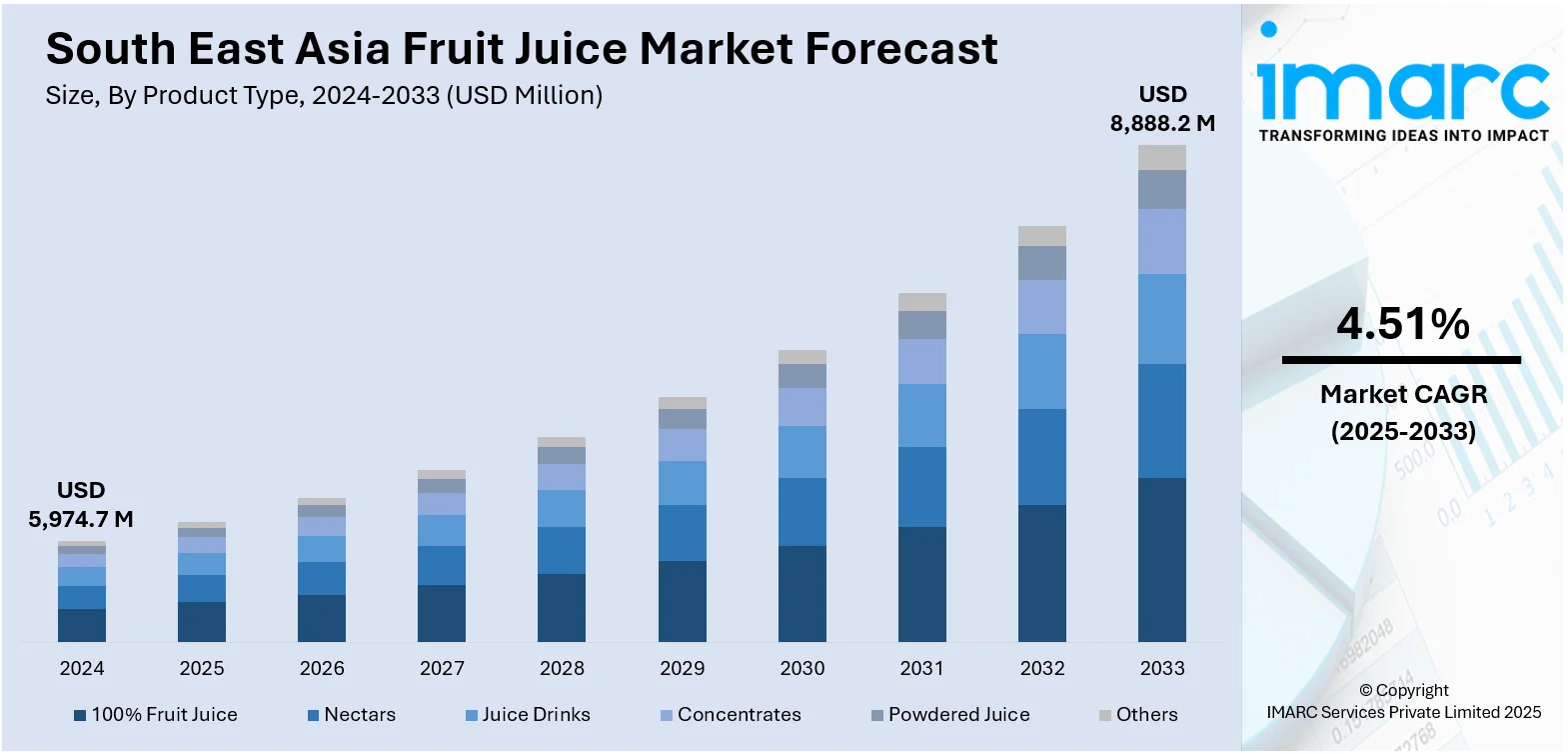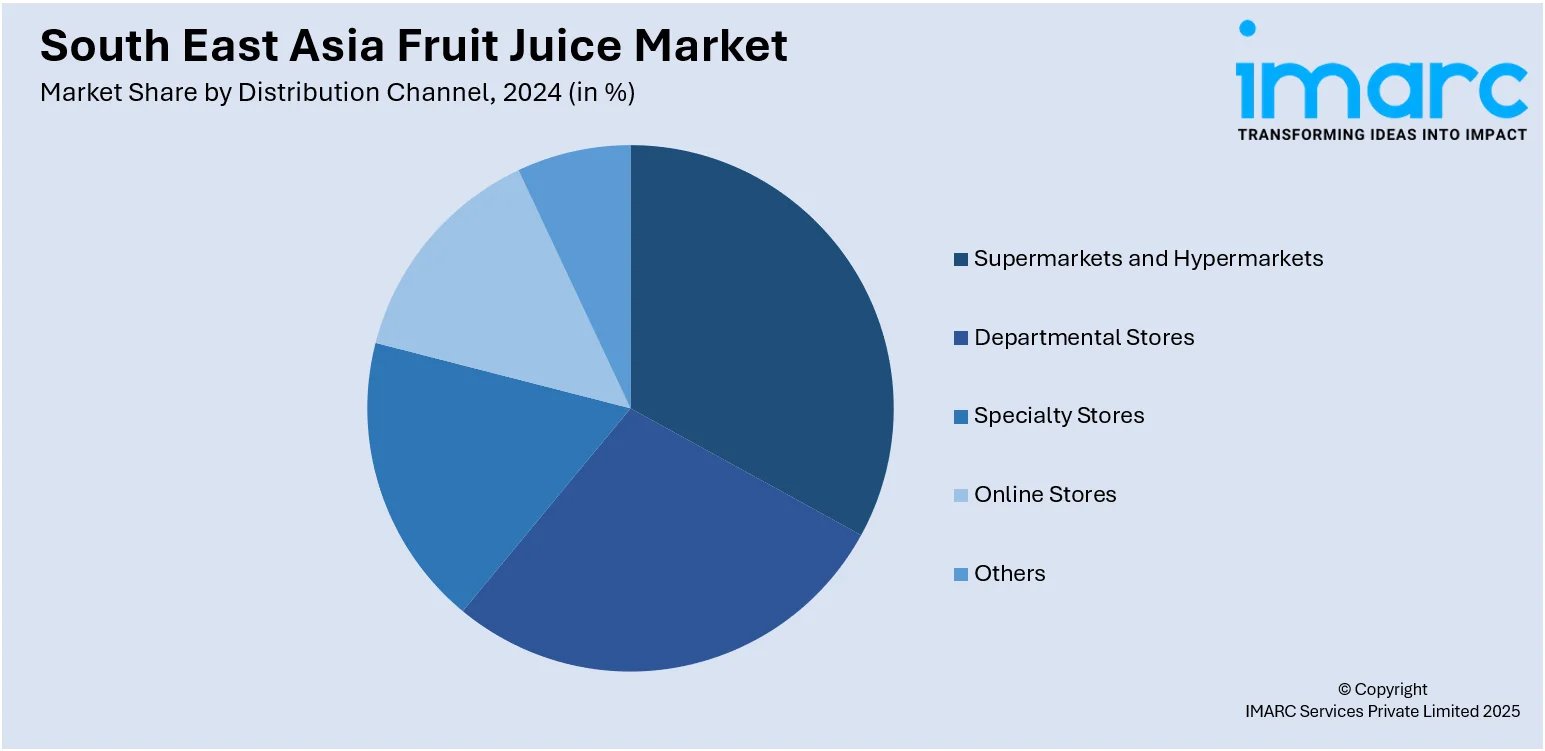
South East Asia Fruit Juice Market Size, Share, Trends and Forecast by Product Type, Flavor, Distribution Channel, and Country, 2025-2033
Market Overview:
South East Asia fruit juice market size reached USD 5,974.7 Million in 2024. Looking forward, IMARC Group expects the market to reach USD 8,888.2 Million by 2033, exhibiting a growth rate (CAGR) of 4.51% during 2025-2033. The growing demand for functional beverages that contribute to overall well-being of individuals, along with the introduction of convenient packaging formats, is primarily driving the regional market.
|
Report Attribute
|
Key Statistics
|
|---|---|
|
Base Year
|
2024
|
|
Forecast Years
|
2025-2033
|
|
Historical Years
|
2019-2024
|
| Market Size in 2024 | USD 5,974.7 Million |
| Market Forecast in 2033 | USD 8,888.2 Million |
| Market Growth Rate 2025-2033 | 4.51% |
Fruit juice is a liquid obtained from various fruits by processes like crushing, pressing, or blending. It's a popular drink known for its refreshing flavor and nutritional advantages. It is often consume by individuals to get vitamins, minerals, and natural sugars. Available in diverse flavors like apple, orange, grape, and pineapple, these juices undergo an extraction method that eliminates solid elements like pulp and fiber, retaining the liquid essence. This liquid is abundant in vitamins, especially vitamin C, and other nutrients dependent on the fruit's composition. It's crucial to acknowledge that while fruit juice offers valuable nutrients, it may also contain natural sugars contributing to overall calorie intake.

To get more information on this market, Request Sample
South East Asia Fruit Juice Market Trends:
The South East Asia fruit juice market is experiencing a robust and dynamic growth trajectory, fueled by the region's increasing urbanization, rising disposable income, and a growing awareness of health and wellness. Additionally, the escalating demand for natural and nutritious beverages is on the rise, aligning with the emerging trend towards healthier lifestyles, which is acting as another significant growth-inducing factor. This has led to a surge in the consumption of fruit juices as consumers seek alternatives to carbonated and sugary drinks. A notable trend within the South East Asia fruit juice market is the inclination towards exotic and tropical fruit flavors. Moreover, the elevating consumer awareness towards embracing regional authenticity and the rich biodiversity that South East Asia offers is positively influencing the regional market. Apart from this, the market is also witnessing innovation in product offerings, with the introduction of functional fruit juices enriched with vitamins, antioxidants, and other health-promoting ingredients. Furthermore, the development of convenient packaging formats that to cater to the on-the-go lifestyle prevalent in the region is also bolstering the regional market. Numerous factors, including changing consumer preferences, health consciousness, and a rich tapestry of indigenous fruit offerings, are projected to catalyze the regional market over the forecasted period.
South East Asia Fruit Juice Market Segmentation:
IMARC Group provides an analysis of the key trends in each segment of the market, along with forecasts at the regional and country levels for 2025-2033. Our report has categorized the market based on product type, flavor, and distribution channel.
Product Type Insights:
- 100% Fruit Juice
- Nectars
- Juice Drinks
- Concentrates
- Powdered Juice
- Others
The report has provided a detailed breakup and analysis of the market based on the product type. This includes 100% fruit juice, nectars, juice drinks, concentrates, powdered juice, and others.
Flavor Insights:
- Orange
- Apple
- Mango
- Mixed Fruit
- Others
A detailed breakup and analysis of the market based on the flavor have also been provided in the report. This includes orange, apple, mango, mixed fruit, and others.
Distribution Channel Insights:

- Supermarkets and Hypermarkets
- Convenience Stores
- Specialty Food Stores
- Online Retail
- Others
The report has provided a detailed breakup and analysis of the market based on the distribution channel. This includes supermarkets and hypermarkets, convenience stores, specialty food stores, online retail, and others.
Country Insights:
- Indonesia
- Thailand
- Singapore
- Philippines
- Vietnam
- Malaysia
- Others
The report has also provided a comprehensive analysis of all the major regional markets, which include Indonesia, Thailand, Singapore, Philippines, Vietnam, Malaysia, and Others.
Competitive Landscape:
The market research report has also provided a comprehensive analysis of the competitive landscape in the market. Competitive analysis such as market structure, key player positioning, top winning strategies, competitive dashboard, and company evaluation quadrant has been covered in the report. Also, detailed profiles of all major companies have been provided.
South East Asia Fruit Juice Market Report Coverage:
| Report Features | Details |
|---|---|
| Base Year of the Analysis | 2024 |
| Historical Period | 2019-2024 |
| Forecast Period | 2025-2033 |
| Units | Million USD |
| Scope of the Report | Exploration of Historical Trends and Market Outlook, Industry Catalysts and Challenges, Segment-Wise Historical and Future Market Assessment:
|
| Product Types Covered | 100% Fruit Juice, Nectars, Juice Drinks, Concentrates, Powdered Juice, Others |
| Flavors Covered | Orange, Apple, Mango, Mixed Fruit, Others |
| Distribution Channels Covered | Supermarkets and Hypermarkets, Convenience Stores, Specialty Food Stores, Online Retail, Others |
| Countries Covered | Indonesia, Thailand, Singapore, Philippines, Vietnam, Malaysia, Others |
| Customization Scope | 10% Free Customization |
| Post-Sale Analyst Support | 10-12 Weeks |
| Delivery Format | PDF and Excel through Email (We can also provide the editable version of the report in PPT/Word format on special request) |
Key Questions Answered in This Report:
- How has the South East Asia fruit juice market performed so far and how will it perform in the coming years?
- What has been the impact of COVID-19 on the South East Asia fruit juice market?
- What is the breakup of the South East Asia fruit juice market on the basis of product type?
- What is the breakup of the South East Asia fruit juice market on the basis of flavor?
- What is the breakup of the South East Asia fruit juice market on the basis of distribution channel?
- What are the various stages in the value chain of the South East Asia fruit juice market?
- What are the key driving factors and challenges in the South East Asia fruit juice?
- What is the structure of the South East Asia fruit juice market and who are the key players?
- What is the degree of competition in the South East Asia fruit juice market?
Key Benefits for Stakeholders:
- IMARC’s industry report offers a comprehensive quantitative analysis of various market segments, historical and current market trends, market forecasts, and dynamics of the South East Asia fruit juice market from 2019-2033.
- The research report provides the latest information on the market drivers, challenges, and opportunities in the South East Asia fruit juice market.
- Porter's five forces analysis assist stakeholders in assessing the impact of new entrants, competitive rivalry, supplier power, buyer power, and the threat of substitution. It helps stakeholders to analyze the level of competition within the South East Asia fruit juice industry and its attractiveness.
- Competitive landscape allows stakeholders to understand their competitive environment and provides an insight into the current positions of key players in the market.
Need more help?
- Speak to our experienced analysts for insights on the current market scenarios.
- Include additional segments and countries to customize the report as per your requirement.
- Gain an unparalleled competitive advantage in your domain by understanding how to utilize the report and positively impacting your operations and revenue.
- For further assistance, please connect with our analysts.
 Request Customization
Request Customization
 Speak to an Analyst
Speak to an Analyst
 Request Brochure
Request Brochure
 Inquire Before Buying
Inquire Before Buying




.webp)




.webp)












